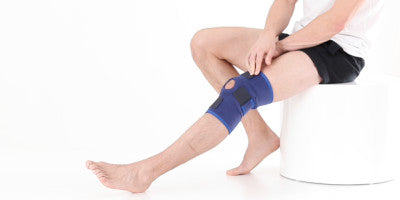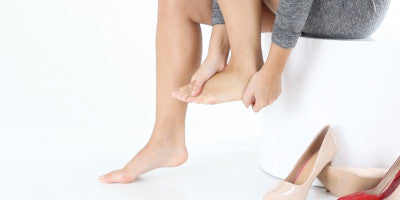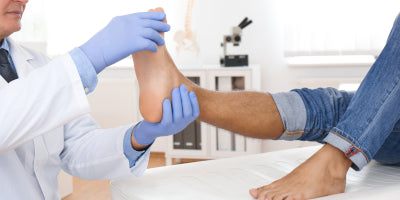What is Arthritis?
Arthritis is a common condition, and cause of joint pain, that affects millions of people worldwide, but it isn't just one disease—it's a term used to describe a group of more than 100 different types of joint disorders. Among the most common types are rheumatoid arthritis, osteoarthritis, gout, and polymyalgia rheumatica, each with its unique causes, arthritis symptoms, and treatment for arthritis. In this blog, we'll explore the answers to some key questions about arthritis: What causes arthritis? Is arthritis hereditary? And perhaps the most important question of all: Is arthritis curable? Whether you're looking for general knowledge or specific information about these conditions, this guide aims to provide clarity and insights.
As the answers to these questions can vary between the types of arthritis, it is best to approach each separately.
What is Osteoarthritis?
Osteoarthritis (OA) is the most common form of arthritis, often referred to as "wear and tear" arthritis, and it disproportionately affects women, particularly as they age. In fact, women are more likely than men to develop osteoarthritis, especially in weight-bearing joints like the knees and hips. This increased prevalence in women is thought to be influenced by factors such as hormonal changes, particularly after menopause, as well as differences in joint structure and biomechanics. Osteoarthritis primarily affects the cartilage, the protective tissue that cushions the ends of bones in your joints. Over time, the cartilage deteriorates, leading to bone-on-bone contact, which results in pain, stiffness, and reduced mobility. While osteoarthritis can impact any joint, it most commonly occurs in the knees, hips, hands, and spine, often limiting day-to-day activities.
Osteoarthritis Symptoms
The symptoms of osteoarthritis develop gradually and worsen over time. The most common symptoms include:
- Joint pain and tenderness, especially during or after movement.
- Stiffness, which is more noticeable after waking up or after periods of inactivity. Loss of flexibility, making it difficult to move the joint fully.
- Grating sensation, sometimes accompanied by popping or cracking sounds when using the joint.
- Swelling around the joint, particularly after extended use. As the condition progresses, people with OA may find it increasingly difficult to perform everyday tasks like walking, gripping objects, or climbing stairs.
Causes of Osteoarthritis
The main cause of osteoarthritis is the gradual breakdown of cartilage due to aging. However, various factors, such as joint injuries, obesity, and genetics, can increase the likelihood of or speed up this process. Injury or trauma to a joint, even if it occurred years ago, can lead to the development of OA in that joint. Repetitive stress from work or sports can also increase the risk. Additionally, obesity is a major factor since excess weight puts more strain on weight-bearing joints like the knees and hips.
While age is the strongest risk factor, other contributors include joint deformities, metabolic disorders like diabetes, and specific types of joint inflammation that predispose someone to cartilage breakdown.
Is Osteoarthritis Hereditary?
Genetics can play a role in the development of osteoarthritis, particularly in cases where it affects the hands. If someone in your family has had OA, you may be at a higher risk of developing it, especially at an earlier age. However, genetic factors are just one part of the picture, with lifestyle, injury, and other health conditions also influencing the risk.
Osteoarthritis Treatment
There is currently no cure for osteoarthritis, but treatments are available to manage symptoms and improve quality of life. These include:
- Medications like pain relievers (acetaminophen, NSAIDs) and anti-inflammatory drugs.
- Physical therapy to strengthen the muscles around the joint, improving support and reducing pain.
- Lifestyle changes, such as weight loss to reduce strain on joints, and low-impact exercises like swimming and cycling to maintain joint mobility.
- Assistive devices like braces or shoe inserts can help alleviate pressure on affected joints.
- In more severe cases, surgical options such as joint replacement (e.g., knee or hip replacement) may be necessary to restore joint function.
Effective management of osteoarthritis often involves a combination of these treatments, tailored to the individual’s symptoms and lifestyle.

"Osteoarthritis primarily affects the cartilage, the protective tissue that cushions the ends of bones in your joints. Over time, the cartilage deteriorates, leading to bone-on-bone contact, which results in pain, stiffness, and reduced mobility. While osteoarthritis can impact any joint, it most commonly occurs in the knees, hips, hands, and spine, often limiting day-to-day activities."
What is Rheumatoid arthritis?
Rheumatoid arthritis (RA) is a chronic autoimmune disorder that primarily affects the joints, causing inflammation, pain, and eventual joint damage. Unlike osteoarthritis, which results from wear and tear, rheumatoid arthritis occurs when the immune system mistakenly attacks the body’s tissues, especially the lining of the joints (synovium). This leads to swelling, joint deformities, and even damage to other organs in severe cases. RA can affect people of all ages, but it most commonly begins between the ages of 30 and 50.
Rheumatoid Arthritis Symptoms
The symptoms of rheumatoid arthritis can vary in intensity and may come and go, but the primary ones include:
- Joint pain, swelling, and tenderness, especially in the small joints of the hands, wrists, and feet.
- Morning stiffness, which can last for hours or even the entire day, making it difficult to move after waking up.
- Fatigue, fever, and a general feeling of being unwell.
- Symmetrical joint involvement, meaning both sides of the body (like both knees or both wrists) are usually affected simultaneously. Over time, RA can cause joint deformities, loss of function, and permanent damage to the cartilage, bones, and surrounding tissues. In some cases, rheumatoid arthritis can also impact other parts of the body, including the eyes, skin, heart, and lungs.
Rheumatoid Arthritis Causes
The exact cause of rheumatoid arthritis is unknown, but it’s understood to be the result of a malfunction in the immune system. Instead of protecting the body from infections, the immune system attacks healthy joint tissues, leading to inflammation. Several factors can contribute to the development of RA:
- Genetic predisposition: Certain genes, especially those involved in the immune system, increase the likelihood of developing RA.
- Environmental factors, such as smoking, have been linked to an increased risk of triggering RA in genetically susceptible individuals.
- Hormonal changes, particularly in women, who are more likely to develop RA than men, especially after pregnancy or during menopause.
Is Rheumatoid Arthritis Hereditary?
While rheumatoid arthritis isn’t directly inherited, having a family member with the condition can increase your risk. Some specific genes related to the immune system, such as the HLA-DRB1 gene, are more common in people with RA. However, having these genes doesn’t guarantee you’ll develop RA—it’s usually a combination of genetics and environmental factors that lead to its onset.
Treatment for Rheumatoid Arthritis
There is no cure for rheumatoid arthritis, but early diagnosis and treatment can help manage symptoms, slow disease progression, and prevent joint damage. Common treatment options include:
- Medications, particularly disease-modifying antirheumatic drugs (DMARDs) like methotrexate and biologics that target specific parts of the immune system to reduce inflammation.
- Nonsteroidal anti-inflammatory drugs (NSAIDs) and corticosteroids to relieve pain and reduce inflammation.
- Physical therapy to improve flexibility and strengthen muscles around the joints, enhancing support and mobility.
- Lifestyle modifications, such as regular low-impact exercise, stress management, and maintaining a healthy weight, can improve overall health and reduce the burden on joints.
- In severe cases, surgery may be needed to repair or replace damaged joints.
With early intervention and a comprehensive treatment plan, many people with rheumatoid arthritis can manage their symptoms effectively and maintain an active, fulfilling life.

A New Positivity For Arthritis Sufferers
What is Gout?
Gout is a form of inflammatory arthritis characterized by sudden, severe pain, redness, and swelling in the joints, most often affecting the big toe. Gout attacks, also known as flare-ups, can occur unexpectedly and often at night, leaving the joint feeling hot and extremely tender. While the big toe is the most common site, gout can also affect the ankles, knees, elbows, wrists, and fingers. The intense pain from a gout flare typically subsides after a few days to weeks, but repeated attacks can lead to permanent joint damage if left untreated.
Gout is caused by the buildup of uric acid in the blood, which forms sharp, needle-like crystals in the joints. Uric acid is produced when the body breaks down purines, substances found in certain foods and drinks like red meat, seafood, alcohol, and sugary beverages. Factors such as obesity, genetics, kidney problems, and certain medications can also increase the risk of developing gout. While there is a hereditary component to gout, lifestyle and dietary habits are often the primary triggers.
Treatment for gout focuses on managing flare-ups and preventing future attacks. This includes nonsteroidal anti-inflammatory drugs (NSAIDs), corticosteroids, or colchicine to relieve pain and inflammation. Long-term management often involves uric acid-lowering medications like allopurinol, along with lifestyle changes such as avoiding purine-rich foods, staying hydrated, and maintaining a healthy weight. With proper treatment and lifestyle adjustments, gout can be effectively controlled, reducing the frequency and severity of attacks.
What is Polymyalgia rheumatica?
Polymyalgia rheumatica (PMR) is an inflammatory disorder that causes muscle pain and stiffness, primarily in the shoulders, neck, and hips. It typically affects people over the age of 50 and is more common in women. Unlike arthritis, which affects the joints, PMR targets the muscles, causing significant discomfort, especially after periods of inactivity, such as in the morning. Other symptoms may include fatigue, mild fever, and weight loss.
The exact cause of PMR is unknown, but it’s thought to involve both genetic and environmental factors, possibly triggered by an infection. While PMR is not considered hereditary, people with a family history of autoimmune diseases may have an increased risk. Fortunately, PMR often responds well to treatment with low doses of corticosteroids, which help reduce inflammation and relieve symptoms. Most people see significant improvement within a few days of starting treatment, though the course of treatment can last several months to prevent relapse.
Since PMR shares symptoms with other inflammatory conditions, early diagnosis and treatment are essential for managing discomfort and preventing complications, such as the development of giant cell arteritis, a related condition that can cause severe headaches and vision problems. With appropriate treatment, most individuals with PMR can lead active, healthy lives.
What is Lupus?
Lupus, particularly systemic lupus erythematosus (SLE), is an autoimmune disease that can cause widespread inflammation throughout the body, including in the joints. When lupus affects the joints, it can lead to lupus arthritis, characterized by joint pain, swelling, and stiffness similar to other forms of arthritis. This joint pain is often accompanied by periods of fatigue and fever, with flare-ups that can vary in intensity. Although lupus arthritis doesn’t typically cause the same level of permanent joint damage seen in conditions like rheumatoid arthritis, it can still significantly impact mobility and quality of life.
The underlying cause of lupus is a malfunction of the immune system, where the body mistakenly attacks its own tissues, including the joints. This immune response can also affect the skin, kidneys, heart, and other organs. The exact causes of lupus are not fully understood, but it is believed to result from a combination of genetics, hormonal factors, and environmental triggers like infections or sunlight. While lupus can run in families, it is not directly inherited, but a family history of autoimmune diseases may increase the risk.
Treatment for lupus-related arthritis often includes nonsteroidal anti-inflammatory drugs (NSAIDs) to relieve joint pain and reduce inflammation, as well as antimalarial medications like hydroxychloroquine, which are effective for managing joint and skin symptoms. In more severe cases, immunosuppressants and corticosteroids may be used to control inflammation. Although there is no cure for lupus, treatment can help manage joint symptoms and prevent flare-ups. Regular exercise, stress management, and avoiding known triggers like sun exposure can also help reduce the impact of lupus arthritis on daily life.
What is Psoriatic Arthritis?
Psoriatic arthritis (PsA) is a form of inflammatory arthritis that affects some people with psoriasis, a chronic skin condition characterized by red, scaly patches. Psoriatic arthritis causes joint pain, stiffness, and swelling, which can range from mild to severe. It most commonly affects the fingers, toes, knees, and lower back, but any joint in the body can be involved. The joint pain in PsA often comes with periods of flare-ups and remissions, and over time, untreated inflammation can lead to permanent joint damage.
Psoriatic arthritis occurs when the immune system mistakenly attacks healthy tissue, leading to inflammation in both the skin and joints. The exact cause is not fully understood, but it’s believed to involve a combination of genetic factors, since PsA tends to run in families, and environmental triggers, such as infections or injury. While psoriasis often precedes the development of arthritis, some people experience joint symptoms before noticing any skin issues.
Treatment for psoriatic arthritis aims to reduce inflammation, relieve pain, and prevent joint damage. Common treatments include nonsteroidal anti-inflammatory drugs (NSAIDs) for pain relief and disease-modifying antirheumatic drugs (DMARDs), like methotrexate, to control inflammation. Biologic therapies that target specific parts of the immune system, such as TNF inhibitors, are also widely used to treat PsA. Physical therapy and regular exercise can help maintain joint flexibility and function. Early diagnosis and appropriate treatment are essential to managing the symptoms of psoriatic arthritis and minimizing long-term joint damage.
What is fibromyalgia?
Fibromyalgia is a chronic condition characterized by widespread musculoskeletal pain, fatigue, and tenderness in specific areas of the body. While fibromyalgia is not a form of arthritis, it is often grouped with arthritis-related conditions because it affects the muscles, joints, and soft tissues, leading to symptoms that resemble those of arthritis. People with fibromyalgia may also experience stiffness, especially in the morning, along with additional symptoms like headaches, sleep disturbances, and problems with concentration (often referred to as "fibro fog").
The exact cause of fibromyalgia is unknown, but it is believed to be related to abnormal processing of pain signals in the brain. Factors that may contribute to its development include genetics, stress, physical trauma, and certain infections. Fibromyalgia tends to run in families, suggesting a hereditary component. Unlike arthritis, fibromyalgia doesn’t cause inflammation or damage to the joints, but the chronic pain and fatigue can have a significant impact on daily activities and overall quality of life.
Treatment for fibromyalgia focuses on managing pain and improving quality of life. This often involves a combination of medications such as pain relievers, antidepressants, and anti-seizure drugs, which help regulate pain perception. Physical therapy, exercise, and stress-reduction techniques like yoga and mindfulness can also help reduce symptoms. Although there is no cure for fibromyalgia, a personalized treatment plan can help individuals manage their symptoms and maintain a more active, fulfilling lifestyle.
What is Enteropathic arthritis?
Enteropathic arthritis is a form of chronic inflammatory arthritis associated with inflammatory bowel diseases (IBD), such as Crohn’s disease and ulcerative colitis. This condition primarily affects the joints and can lead to pain, swelling, and stiffness, particularly in the spine and lower limbs. Like other types of arthritis, enteropathic arthritis can fluctuate, with periods of flare-ups and remissions. In addition to joint symptoms, individuals often experience digestive issues linked to their underlying bowel condition, such as abdominal pain, diarrhea, and weight loss.
The exact cause of enteropathic arthritis is not entirely understood, but it is believed to be related to the body’s immune response. In people with IBD, the immune system attacks the gastrointestinal tract, and this same inflammation can spread to the joints. Genetics, environmental factors, and gut bacteria also play a role in its development. While enteropathic arthritis is not strictly hereditary, having a family history of IBD or related autoimmune conditions can increase the risk.
Treatment for enteropathic arthritis typically involves managing both the joint inflammation and the underlying bowel disease. This includes the use of nonsteroidal anti-inflammatory drugs (NSAIDs), corticosteroids, and disease-modifying antirheumatic drugs (DMARDs) to control inflammation. Biologic therapies, such as TNF inhibitors, can be effective in treating both IBD and joint symptoms. Lifestyle changes, including regular low-impact exercise and maintaining a healthy diet, are also important for managing symptoms and improving overall quality of life. Early diagnosis and comprehensive treatment can help minimize joint damage and improve long-term outcomes.

"Rheumatoid arthritis (RA) is a chronic autoimmune disorder that primarily affects the joints, causing inflammation, pain, and eventual joint damage."
In conclusion, arthritis encompasses a wide range of conditions, each with its unique causes, symptoms, and treatment approaches. From the wear and tear of osteoarthritis to the immune system malfunctions in rheumatoid arthritis and psoriatic arthritis, understanding the different types of arthritis is essential for managing symptoms and improving quality of life. While some forms of arthritis, like gout or enteropathic arthritis, are linked to underlying health conditions, others, such as fibromyalgia, involve complex pain processing mechanisms. Regardless of the type, early diagnosis and tailored treatment can help individuals maintain mobility, reduce pain, and prevent long-term damage.
Although there is no cure for most forms of arthritis, advancements in medication, physical therapy, and lifestyle modifications offer effective ways to manage the condition. If you or a loved one is living with arthritis, understanding the different types and their treatments is the first step toward taking control of your health. With proper care, many people with arthritis lead active, fulfilling lives despite the challenges it presents. Don’t hesitate to consult with a healthcare provider to find the best management plan for your specific needs.
Disclaimer
The content on this website is provided for general information and reference purposes only and is not intended to substitute for advice given by a physician, pharmacist, or other licensed health-care professional. You should not use this information as self-diagnosis or for treating a health problem or disease. All exercises and information featured on this web site should only be reviewed/practised under the supervision of a qualified healthcare professional. Products suggestions linked to injuries may be provided on the site but you must always refer to the product page for full product details and always consult a physician before use as the indications outlined may not always be relevant to your particular injury/condition.






























